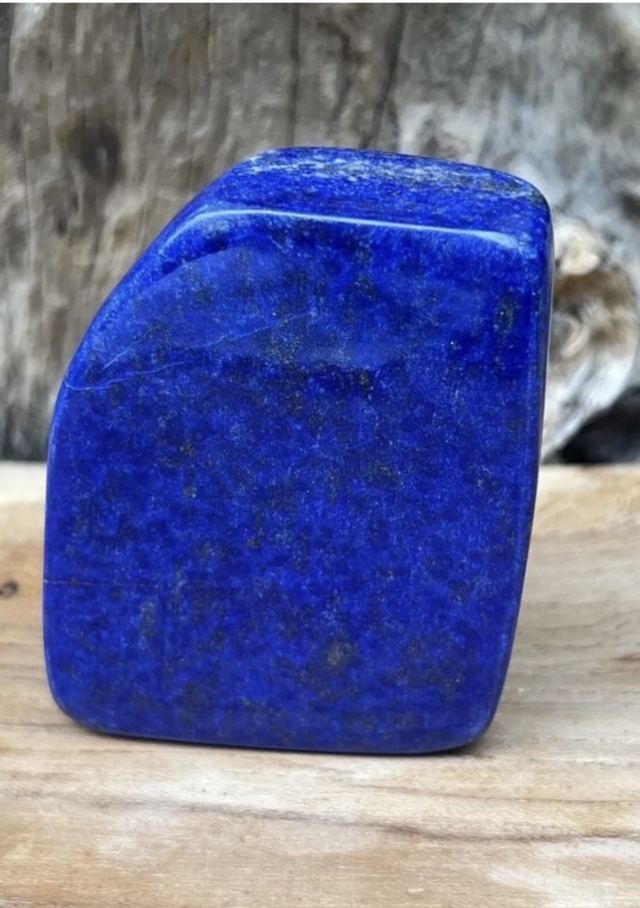
Our Blog
Lapis Lazuli - the Deep Blue Crystal

Lapis Lazuli is a beneficial healing crystal for me. I get a warm feeling of imparted wisdom when I hold this stone, alongside a feeling of protection and serenity. But this is just me, I also feel very connected back to ancient times.
Lapis Lazuli is a throat chakra crystal it quickly releases stress, bringing deep peace. It brings harmony and deep inner self-knowledge. Encourages self-awareness, allows self-expression and reveals inner truth, providing qualities of honesty, compassion and morality to the personality.
The History of Lapis Lazuli
Lapis Lazuli is one of the oldest opaque gemstones in history it dates back more than 6,500 years.
This deep blue stone includes tiny flecks of mica, like a night sky full of stars. It's most well-known source is deep in the mountains of modern Afghanistan.
This stone's two-part name comes from two different cultures Lapis is a Latin word meaning stone while Lazuli comes from the Persian word lazhuward, meaning "blue."
It is not an element nor a mineral--it is a rock containing multiple minerals: lazurite, diopside, calcite, pyrite and more.
Biblical scholars believe that references in the Old Testament to "sapphire" actually indicate lapis lazuli, as the sapphire gemstone was not known in the Middle East before the Roman Empire. Beloved by the ancient Egyptians, Babylonians, Minoans, Chinese, Greeks and up to the Romans, this deep blue stone has been used in the finest of art through the ages. One of the most famous uses of the stone is in the death mask of King Tutankhamen, where it is inlaid with turquoise and carnelian in bright gold. One of his successors, Cleopatra, was known to use ground lapis lazuli as eyeshadow. Marco Polo wrote about the lapis lazuli mines way back in the 13th century.
In the middle ages, painters ground up Lapis Lazuli to make the deep blue paint called ultramarine--the blue used to paint the robes of Mary of Nazareth on church walls and ceilings like in the Sistine Chapel. Meanwhile, in South America, pre-Columbian cultures such as the Diguita and Inca were carving, trading and warring over Lapis Lazuli from mines in what is now Argentina and Chile.
Lapis Lazuli Physical Properties
The Sumerians believed that the spirit of their gods lived within the stone, while the ancient Egyptians saw it as a symbol of the night sky. Since the earliest of times, Lapis Lazuli has been associated with strength and courage, royalty and wisdom, intellect and truth.
From antiquity, Lapis Lazuli has been worn in the belief that it will ward off evil. In ancient Egypt, it was powdered and worn about the eyes to improve eyesight. Today, it is considered by some to be an aid to balancing the brow chakra (which influences vision and hearing). Imbalances of the brow (or blue) chakra are said to cause headaches, anxiety and disorders of the skin.
Lapis Lazuli Physical Properties
Lapis Lazuli is an intensely blue stone made of a deep blue lazurite, cloudy white calcite, sparkly pyrite and other minerals. This beautiful mixture of textures gives lapis lazuli its characteristic look.
Lapis lazuli is found with limestone or as separate boulders. Stones from what is now modern Afghanistan and Pakistan are still considered to be of the best quality. Argentina also produces a premium deep blue variety. Lapis Lazuli is found in the USA and Canada and less intense blue examples are found in Chile and in the former USSR.
How to Care for Lapis Lazuli
Lapis Lazuli sits in the middle of the Mohs Hardness Scale, making it harder than a range of other popular stones, yet softer than many transparent faceted gems. Lapis is sensitive to pressure, heat and (with its calcite content) household cleaners and abrasives. Lapis Lazuli should not be placed in direct sunlight for longer periods of time as the sun can cause the colour of the stone to fade.
Even though Lapis Lazuli can go in water, it is not recommended to leave the stone in water for extended periods of time due to its porous nature. Clean undyed lapis with lukewarm soapy water; test dyed materials to see how they react to water before cleaning. Wipe them with a soft cloth and store dry, in a separate bag or box where it can neither scratch nor be scratched by other jewellery. Avoid ultrasound and steam cleaners.
Back